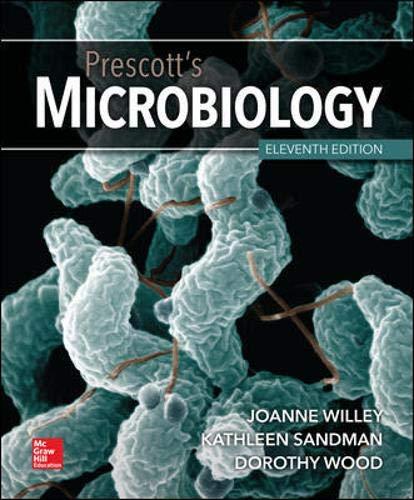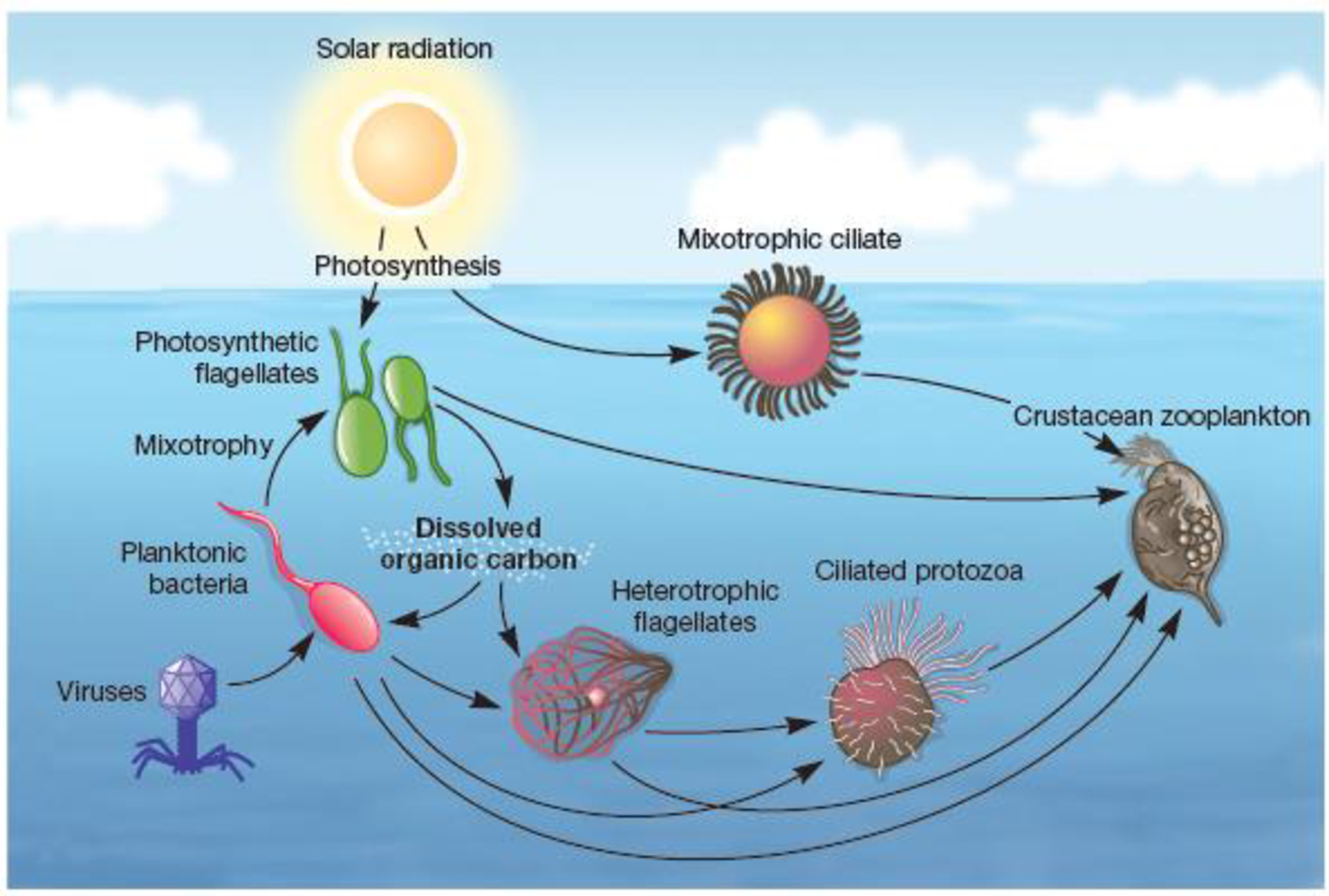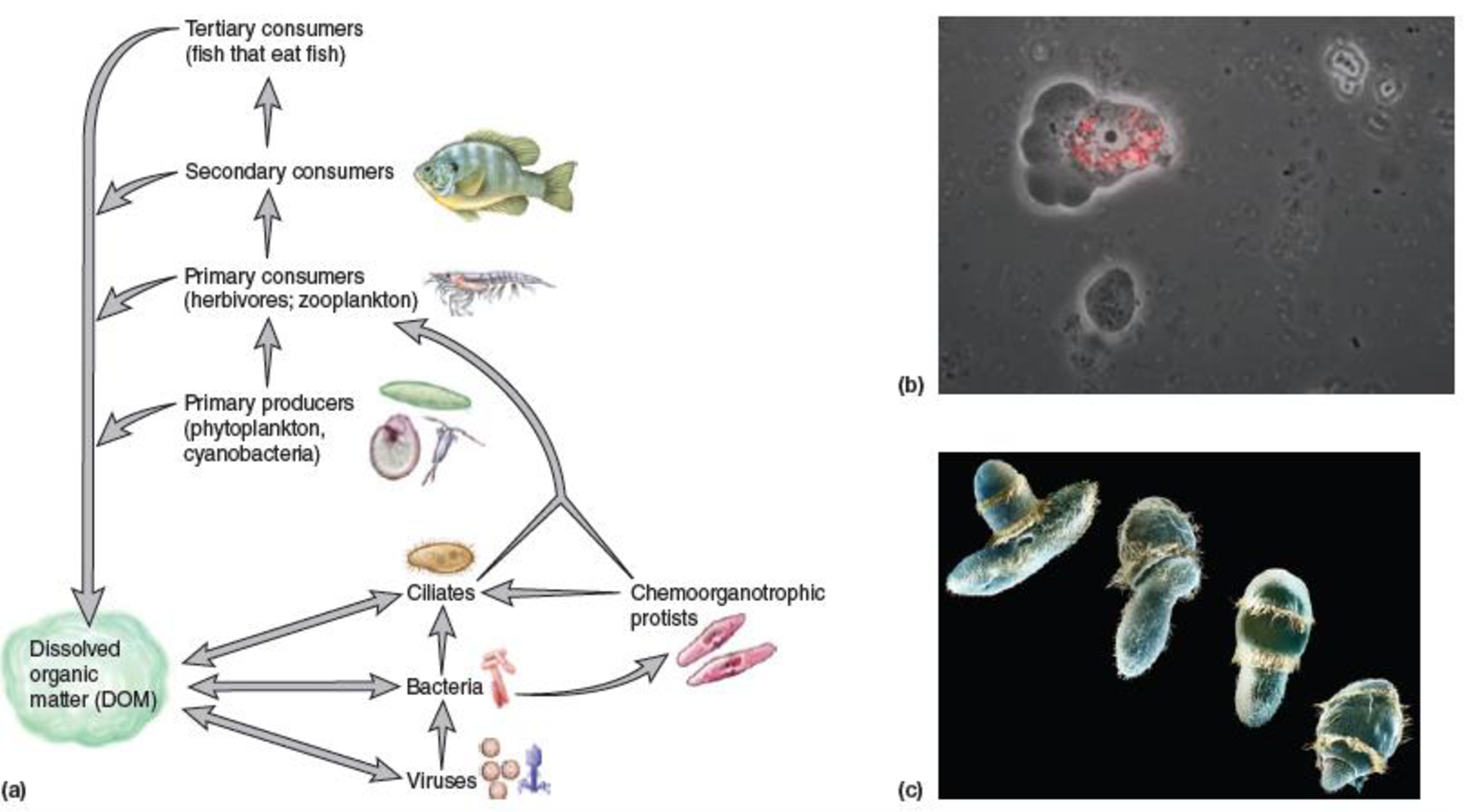
Concept explainers

Figure 30.15 Nutrient Cycling in Antarctic Lakes Is Performed Entirely by Microbes. Antarctic glacial lakes lack multicellular organisms, so all nutrient cycling is between various types of microbes, including bacteriophages. The surrounding environment provides some organic carbon.
List three major differences between this microbial loop and that found in the open ocean (figure 30.6).

Figure 30.6 The Microbial Loop. (a) Microorganisms play vital roles in ecosystems as primary producers, decomposers, and primary consumers. All organisms contribute to a common pool of dissolved organic matter (DOM) that is consumed by microbes. Viruses contribute DOM by lysing their hosts, and bacterial and archaeal cells are consumed by protists, which also consume other protists. These microbes are then consumed by herbivores that often select food items by size, thereby ingesting both heterotrophic and autotrophic microbes. Thus nutrient cycling is a complex system driven in large part by microbes. (b) Protists consume bacteria; in this case, a naked amoeba is consuming the cyanobacterium Synechococcus sp. which fluoresces red. (c) Protists consume protists; here, the ciliate Didinium sp. (rounded organism with two rows of cilia) is preying upon another ciliate, Paramecium sp.
Want to see the full answer?
Check out a sample textbook solution
Chapter 30 Solutions
Prescott's Microbiology
- Figure 46.17 Which of the following statements about the nitrogen cycle is false? Ammonification converts organic nitrogenous matter from living organisms into ammonium (NH4+). Denitrification by bacteria converts nitrates (NO3-) to nitrogen gas (N2). Nitrification by bacteria converts nitrates (NO3 ) to nitrites (NO2-). Nitrogen fixing bacteria convert nitrogen gas (N2) into organic compounds.arrow_forwardContrast and compare the microbial communities found in lotic systems with those in lentic systemsarrow_forwardWhich of the following is a process of the nitrogen cycle that involves the conversion of nitrogen gas to ammonia? a.Nitrogen fixation b.Nitrification c.Ammonification d.Denitrificationarrow_forward
- With reference to the phosphorus cycle, explain the benefits of phosphate solubilizing microorganisms to plants and Discuss how the activities of symbionts in a mutualistic association can lead to microbial weathering (1000 words).arrow_forwardWhich of the following is NOT the usual mechanism of transport of atmospheric microbes? A. Gravimetric deposition B. Wind updraft C. Precipitation D. Evaporationarrow_forwardSome of the organic material manufactured in estuarine communitiesis exported to other ecosystems. What type of ecosystems receive thismaterial? How is this material transported?arrow_forward
- The Lazy River Environmental Group organized a major cleanup of the pollution from the old factory in late 2010. Measurements of pollution in river sediments before and after the cleanup were analyzed to determine the effectiveness of the cleanup. Select the Sediment Pollutant Over Time dataset and follow the interactive to graph the data. What statement best describes the results of the clean up?arrow_forwardWhy is there a high concentration of microbes in the rhizosphere?arrow_forwardConsider figure 49.8 in the textbook. Note the red versus blue squares and the red versus blue bars in the graph. Please choose all applicable options. a.The difference in color (red versus blue) corresponds to a difference in an abiotic factor. b.The difference in color intensity (dark red versus light red) corresponds to a difference in a biotic factor. c.The difference in color (red versus blue) corresponds to a difference in a biotic factor. d.The difference in color intensity (dark red versus light red) corresponds to a difference in an abiotic factor.arrow_forward
- Which of the following factors would explain why there is a decreasing trend of microbial population from top to bottom? A. There is a shift in the condition form oxic to anoxic. B. All statements are acceptable. C. The soil particles become larger and not weathered. D. There is a decrease in the available nutrients.arrow_forwardWhich of the following is NOT a mechanism of how microbes are able to reach deep subsurface portions of the crust? A. Water leaching B. Via gaps in the crust layer. C. Microbial degradation of top surface material D. Ground waterarrow_forwardmicrobes in the soil converting no3- to n2? nitrogen fixation denitrification nitrification ammonificationarrow_forward
 Biology 2eBiologyISBN:9781947172517Author:Matthew Douglas, Jung Choi, Mary Ann ClarkPublisher:OpenStax
Biology 2eBiologyISBN:9781947172517Author:Matthew Douglas, Jung Choi, Mary Ann ClarkPublisher:OpenStax Concepts of BiologyBiologyISBN:9781938168116Author:Samantha Fowler, Rebecca Roush, James WisePublisher:OpenStax College
Concepts of BiologyBiologyISBN:9781938168116Author:Samantha Fowler, Rebecca Roush, James WisePublisher:OpenStax College

